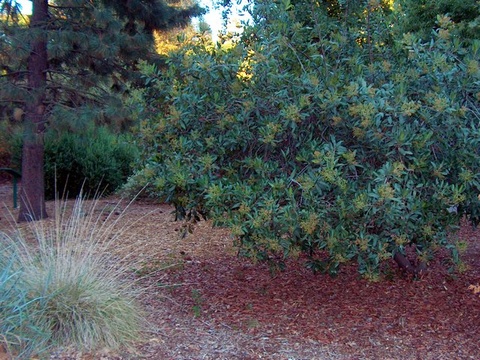Pome fruits are native edible fruits in the Pyrinae subtribe of the Spiraeoideae subfamily of the rose family. The Pyrinae subtribe also contains such familiar non-native fruits as apples and pears.
Because the native pome fruits have not been bred for maximum food production, their fruits tend to be smaller than the more familiar pome fruits sold in grocery stores. However, many less familiar fruits taste just as good as the familiar ones. The Incredible Edibles page on the Las Pilitas Nursery website provides a guide to preparing unfamiliar native fruits and other edible plants.
Cream Bush
 Ocean spray (Holodiscus discolor). Photo by queerbychoice. Cream bush (also called ocean spray) is a ten- to twelve-foot tall by ten-foot-wide, white-flowering, semi-deciduous shrub that is native to Yuba and Sutter Counties and typically grows at elevations below 9,500 feet. Its berries are edible. It is most often found on rocky slopes in yellow pine forest and riparian forest. It prefers full sun and is equally likely to occur in wetlands or non wetlands. It attracts Western tanagers.
Ocean spray (Holodiscus discolor). Photo by queerbychoice. Cream bush (also called ocean spray) is a ten- to twelve-foot tall by ten-foot-wide, white-flowering, semi-deciduous shrub that is native to Yuba and Sutter Counties and typically grows at elevations below 9,500 feet. Its berries are edible. It is most often found on rocky slopes in yellow pine forest and riparian forest. It prefers full sun and is equally likely to occur in wetlands or non wetlands. It attracts Western tanagers.
You can read more about it at the Theodore Payne Wiki, the Las Pilitas Nursery website, and USDA Conservation Plant Characteristics. You can find out where to buy it at the California Native Plant Link Exchange. You can see pictures of it at CalPhotos, Flickr, and Picasa.
Small-Leaf Cream Bush
Small-leaf cream bush (also called rock spiraea) is a three-foot-tall, white-flowering, deciduous shrub that is native to Yuba and Sutter Counties and typically grows at elevations between 2,000 and 13,000 feet. Its berries are edible. It is found in yellow pine forest and riparian forest. It is equally likely to occur in wetlands or non wetlands. It attracts Western tanagers.
You can read more about it at the Theodore Payne Wiki and the Las Pilitas Nursery website. You can find out where to buy it at the California Native Plant Link Exchange. You can see pictures of it at CalPhotos, Flickr, and Picasa.
Toyon
 Toyon (Heteromeles arbutifolia) in the California State University Sacramento arboretum. The clusters of berries will turn bright red as they ripen. Photo by queerbychoice. Toyon is an eight- to occasionally twenty-foot-tall by ten- to fifteen-foot-wide, white-flowering, evergreen shrub or small tree that is native to Yuba and Sutter Counties and typically grows at elevations below 4,000 feet. Its berries are edible. It is most often found in canyons and on slopes in central oak woodland. It attracts Bewick's wrens, Western bluebirds, and Western scrub jays.
Toyon (Heteromeles arbutifolia) in the California State University Sacramento arboretum. The clusters of berries will turn bright red as they ripen. Photo by queerbychoice. Toyon is an eight- to occasionally twenty-foot-tall by ten- to fifteen-foot-wide, white-flowering, evergreen shrub or small tree that is native to Yuba and Sutter Counties and typically grows at elevations below 4,000 feet. Its berries are edible. It is most often found in canyons and on slopes in central oak woodland. It attracts Bewick's wrens, Western bluebirds, and Western scrub jays.
You can read more about it at the Theodore Payne Wiki and the Las Pilitas Nursery website. You can find out where to buy it at the California Native Plant Link Exchange. You can see pictures of it at CalPhotos, Flickr, and Picasa.
Saskatoon Serviceberry
Saskatoon serviceberry is a five- to fifteen-foot-tall by eight-foot-wide, white-flowering, deciduous shrub that is native to Yuba County and typically grows at elevations between 200 and 8,500 feet. Its berries are edible. It is most often found in yellow pine forest. It attracts Western tanager.
You can read more about it at the Theodore Payne Wiki, the Las Pilitas Nursery website, and USDA Conservation Plant Characteristics. You can find out where to buy it at the California Native Plant Link Exchange. You can see pictures of it at CalPhotos, Flickr, and Picasa.


